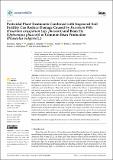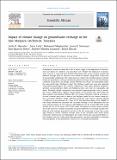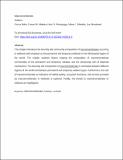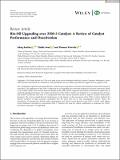Materials, Energy, Water and Environmental Sciences: Recent submissions
Now showing items 101-120 of 692
-
Fluoride and pathogens removal from water using combined electrocoagulation-inline-electrolytic disinfection process
(NM-AIST, 2024-08)The consecutive removal of fluoride (defluoridation) and pathogens (disinfection) in drinking water through combined electrocoagulation-inline-electrolytic disinfection (EC–ECl2) process with aluminum and dimension-stable ... -
Potential use of zero-valent iron in enhancing performance and resource recovery during the anaerobic digestion of domestic sewage
(NM-AIST, 2024-08)Incorporating metallic iron (Fe 0 ) into anaerobic digesters can improve organics (chemical oxygen demand (COD)), phosphorus, and nitrogen from contaminated water. However, no study has systematically assessed ... -
Investigation of uranium derived from phosphate fertilizers on plants uptakes and bacterial diversity in selected agricultural soils of east africa
(NM-AIST, 2024-08)Different types of phosphate fertilizers (PFs) used in agriculture to increase soil fertility contain uranium (U) as an accompanying element. Uranium is both toxic and slightly radioactive. This study investigated the ... -
Assessment of Mpanda groundwater contamination and the effectiveness of the baobab seeds-derived biochar for iron removal from groundwater
(NM-AIST, 2024-08)Groundwater in Mpanda District, Tanzania, faces excessive iron content, causing a reddish brown colouration due to oxidized iron species. The present study evaluated Mpanda groundwater contamination and the effectiveness ... -
Valorisation of solid sisal leaves decortication wastes using black soldier fly (hermetia illucens l.) larvae
(NM-AIST, 2024-08)The amount of waste generated from sisal industries during sisal fiber production is huge and its management is still challenging and a menace to the environment. These wastes include sisal wastewater and sisal leaf ... -
Optimization of arsenic(III) and mercury(II) removal from non-competitive and competitive sorption systems onto activated carbon
(NM-AIST, 2024-07)Heavy metals exist in the ecosystem both naturally and due to anthropogenic activities and as recalcitrant pollutants; they are non-biodegradable and cause acute and chronic diseases to human beings and many lifeforms. ... -
Design of an evaporative cooling system integrated with ultraviolet light for preservation of fruits and vegetables at variable tropical weather conditions: a case study of Arusha, Tanzania
(NM-AIST, 2024-07)Problems with fruits and vegetables spoiling after harvest are particularly acute in tropical regions. This research presents the design, construction, and performance assessment of a solar-powered evaporative cooling ... -
More than pollutant removal: constructed wetlands and waste stabilization ponds as biodiversity hotspots and community assets in Tanzania
(NM-AIST, 2024-05)Waste stabilization ponds (WSPs) and constructed wetlands (CWs) are important ecotechnologies for wastewater treatment. Despite their potential and wastewater management being challenging in urban and peri-urban areas ... -
Solvothermal liquefaction of orange peels and catalytic upgrading of biocrude into transportation fuel over a hybrid catalyst
(NM-AIST, 2024-08)The efficient valorization of biomass for energy-derived biocrudes is essential for effective waste management. However, the production of biocrudes with high energy and reduced oxygen contents during the liquefaction ... -
Naturally occurring metal oxides from rocks as capacitive deionization electrode materials for antibacterial activities
(NM-AIST, 2024-01)The availability of clean and safe drinking water remains a prominent challenge in most parts of the world. Drinking water should be free from harmful microorganisms, salt as well as other organic and inorganic ... -
Influence of rice husk derived nano-silica on performance, emissions, and combustion characteristics of diesel engine fueled with baobab biodiesel
(NM-AIST, 2024-08)The increasing number of on-road automobiles as a result of an exponential increase in population and lifestyle places enormous strain on depleted fossil petroleum fuel, energy security, and environmental stability. ... -
The removal of arsenic from synthetic solution using a sand filter coupled with zero valent iron
(NM-AIST, 2024-07)Contamination of groundwater with arsenic (As) poses a serious risk to public health, demanding the development of effective remediation technology. This study investigated the use of sand filters coupled with of ... -
Effect of irrigation water cut-off position along furrows on water saving and productivity
(NM-AIST, 2024-08)Despite being widely practised technique by smallholder farmers, cut-off technique continues to register low productivity and has not been adequately investigated to improve the status quo. This study aimed to investigate ... -
Emerging pollution, antimicrobial resistance, and the applicability of biochar adsorbents: A comprehensive study in African water systems
(NM-AIST, 2024-07)The impacts of antimicrobial resistance (AMR) extend far beyond clinical settings, permeating into agriculture and the economy, precipitating dire consequences such as compromised treatment efficacy, diminished ... -
Computational and experimental performance analysis of a runner for gravitational water vortex power plant
(NM-AIST, 2024-08)Energy generation through water is one of the most economic sources of power. On the other hand, isolated and rural communities can both benefit from using micro-hydropower to power their homes. The gravitational water ... -
Pesticidal Plant Treatments Combined with Improved Soil Fertility Can Reduce Damage Caused by Fusarium Wilt (Fusarium oxysporum f.sp. phaseoli) and Bean Fly (Ophiomyia phaseoli) in Common Bean Production (Phaseolus vulgaris L.)
(MDPI, 2024-06-06)Common bean production is constrained by a multitude of biotic constraints including bean flies and Fusarium wilt in tropical and subtropical farming systems globally. As these pests and diseases attack the crop beneath ... -
A comprehensive review on the distribution of per- and poly-fluoroalkyl substances in the environment across Sub-Saharan Africa revealed significant variation in their concentrations
(Elsevier, 2024-08)Per- and polyfluoroalkyl substances (PFAS) are a group of synthetic chemicals known for their widespread use in various industrial and consumer products. They enter the food chain via contaminated water, air, and soil, ... -
Impact of climate change on groundwater recharge in the lake Manyara catchment, Tanzania
(Elsevier, 2021-12-15)Groundwater account for about 60 to 80% of water supply to the population of Tanzania's semi-arid regions for domestic and agriculture uses. Despite the importance of groundwater resource in semi-arid areas, limited ... -
Macroinvertebrates
(Elsevier, 2022-01-14)This chapter introduces the diversity and community composition of macroinvertebrates occurring in wetlands with emphasis on the permanent and temporary wetlands in the Afrotropical region of the world. The chapter explores ... -
io-Oil Upgrading over ZSM-5 Catalyst: A Review of Catalyst Performance and Deactivation
(wiley, 2023-12-27)Due to population explosion and industrialization, waste biomass and polymer conversion into biofuel has attracted the interest of researchers. The application of the ZSM-5 catalyst for bio-oil upgrading into renewable ...




















